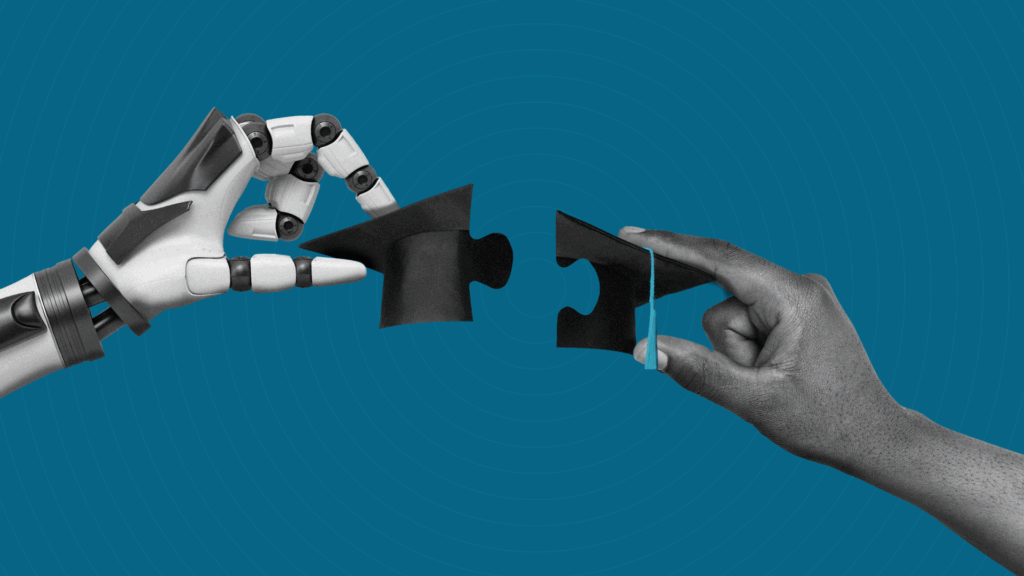Consider the humble pocketknife. For most owners, it will never do more than cut a tangled fishing line or serve as an emergency bottle opener. But, in the right hands, that tool can create carvings of exquisite beauty and detail.
Now, consider Artificial Intelligence. While its capabilities may be infinitely more complex and seemingly limitless, AI is also—like the pocketknife—a tool. To the neophyte, it’s more of a toy that creates fantastical images and works like a newer, smarter, faster search engine. To learners looking for easy, if not ethical, solutions, it can “ghostwrite” papers, take and summarize course notes, and even create convincing “deep fakes”.
But, to extract from AI the real and maximum benefit to society, we must train the next generation of workers to be AI “artisans”. To know the ins and outs of prompts, algorithms, and Natural Processing Language. In the hands of an expert, AI can recreate frescoes from tiny bits of debris in the remains of Pompeii, optimize the effectiveness of in vitro fertilization, and even create comfortable high-heel shoes. The only limits are imagination and AI skill. In this piece, we’ll take a look at the importance of building industry-ready graduates and why AI literacy must be viewed as an indispensable, core skill.
Why AI Literacy Matters
AI literacy has been called the new skills gap. In the simplest terms, AI literacy matters because it has the power to transform any industry. Companies with the vision to incorporate AI in new, creative ways will undoubtedly outperform non-AI competitors over time. But why exactly is it so important to introduce AI as part of higher education?
Industry and Societal Transformation
As a tool of industry, AI excels at automating tasks, enhancing decision-making, and creating new job roles while making others obsolete. Furthermore, its reach far exceeds the bounds of tech-based industries, touching creative arts, medicine, politics, and more. AI’s role in our personal lives also continues to evolve from search engine to personal assistant, life coach, and even therapist. Two words come to mind when thinking of the future of AI: inevitable omnipresence.
Developing Problem-Solving Skills
The value of AI in developing these skills is dependent not only on the quality of the individual teaching tool, but also the willingness of the learner to actively engage. AI is highly functional and valuable as a passive answer generator, but viewing it as an active collaborator creates breakthrough opportunities for generating, comparing, and refining ideas.
Employer Expectations
From slide rules to calculators to AI, there is nothing new about employers expecting graduates to be well-versed in the latest technologies, and it is incumbent upon institutions to equip learners with the skills industry requires.
Future-Proofing Careers
AI-literacy enables graduates to adapt to evolving job markets, ensuring their skills remain relevant and competitive. It is important to note that AI-literacy is not a learn-it-once concept. Successful employees will stay abreast of AI advances and constantly seek new solutions and methodologies, reducing the risk of obsolescence.
What Constitutes AI Literacy?
AI literacy is not limited to technical expertise; it also involves practical and ethical understanding. While similar, AI literacy and data literacy require distinctive tool sets. Data literacy equips employees at all levels with the skills to interpret, analyze, and leverage data in their decision-making processes. On the other hand, AI literacy empowers teams to effectively deploy and interact with AI tools, understanding both their capabilities and limitations.
Put another way, data literacy is the essential groundwork; without it, AI literacy is incomplete and potentially risky, as effective AI use depends on understanding the data that powers it. As with any new tool, developing proficiency with AI requires stepwise and ongoing learning to understand how generative AI works, be able to use it effectively, know how to evaluate its output, and understand its weaknesses and dangers.
Foundational Knowledge
It is critical to start with a basic understanding of how AI and machine learning work, their capabilities, and limitations. This includes knowledge of how AI systems perceive the world, collect and process data, and make decisions or recommendations. It’s also about understanding the capabilities of AI—such as pattern recognition, machine learning, and natural language processing—as well as its limitations. For instance, it is important to recognize that AI systems are only as good as the data they are trained on, and that they can make errors or be influenced by biases present in the data.
Technical Skills and Practical Application
Much like AI itself, we learn from experience. Using AI tools—like chatbots, data analysis platforms, or generative AI—and experimenting with prompt engineering will help users find the answers they seek while also helping them become more effective “askers”.
Critical Thinking
As mentioned, AI is most effective when used as a supplement rather than a replacement for human thinking. It can be used as a tool to learn problem solving and critical analysis skills, but it must also be the subject of those skills. AI can generate plausible-sounding but incorrect or biased information, so humans must critically assess and fact-check what AI produces rather than accept it at face value
Ethics and Accountability
AI literacy also means understanding the ethical and societal impacts of AI, including bias, privacy risks, and the importance of transparency and accountability. Awareness of these realities and understanding how to address them when evaluating AI content reduce risks for employers while building trust with customers, employees, and stakeholders.
Staying Current
As we explored in “From Risk to Reputation: The Hidden Cost of Outdated Curriculum”, the exponential growth of technology and global knowledge is likely to continue, ensuring a need for regular updating of course content to ensure students are leaving with the most current skills and understanding. It also creates a need for continuous learning programs and certifications for working adults whose careers rely on staying abreast of technology.
Impact on Teaching and Learning
From situational analysis through development and implementation and all the way to evaluation and review, AI can play a variety of roles in designing course content. And while this article is focused on the importance of AI as a learning topic in and of itself, it is worthwhile to acknowledge the role that AI can play in course design for any subject.
Personalization and Adaptivity
By analyzing student data AI can tailor content, activities, and assessments to each learner’s unique learning needs and preferences. This personalization helps close knowledge gaps and supports differentiated instruction. Among tools available for customization are:
- Adaptive Learning Platforms – Adjust the difficulty, sequence, and format of materials in real time, ensuring each student gets content that matches their proficiency and pace.
- Intelligent Tutoring – AI-driven tutors provide one-on-one guidance, targeted feedback, and extra practice in areas where students struggle, simulating personalized mentorship and fostering deeper understanding.
- Personalized Recommendations – Algorithms suggest additional resources based on a student’s interests, past performance, learning objectives, and more to help them efficiently discover supplemental learning materials.
- Automated Assessment and Feedback – Quick grade assignments and detailed, individualized feedback, enable students to identify areas for improvement and track their progress more effectively.
- Predictive Analytics – AI can identify students at risk of falling behind by analyzing engagement and performance data. This knowledge enables students to seek additional support and instructors to intervene early.
- Multimodal Learning Experiences – Integrate text, audio, video, and interactive elements that allow students to engage with content in ways that best suit their learning preferences.
- AI Chatbots and Virtual Assistants – These tools answer questions, provide explanations, and offer reminders, enabling students to get instant support and develop self-advocacy skills.
Content Creation and Curation
AI tools assist educators in generating and updating curriculum materials, including text, images, videos, and interactive simulations. This ensures content is current, relevant, and engaging, while also reducing the manual workload for teachers and designers. This labor-saving tool facilitates the kind of regular course updates discussed in detail in our article From Risk to Reputation: The Hidden Cost of Outdated Curriculum.
Changing Roles for Teachers and Students
The integration of AI shifts the teacher’s role from information provider to facilitator and mentor, while students gain more autonomy, using AI tools for creative exploration and problem-solving. Instructors must become highly skilled in AI and its applications to specific courses or industries, but they must also be able to distinguish raw AI-generated content and monitor for other potential student honor violations.
Assessment and Feedback
AI can automate and refine assessments, providing real-time feedback and analytics to both students and instructors. This supports continuous improvement and more targeted interventions.
What’s Next for You—and Higher Ed?
From slide rules to AI, the tools may evolve, but the core question remains: how are institutions like yours preparing students for a fast-changing workforce? We’ve only scratched the surface of AI’s role in reshaping education and employment. In part two of this article, we’ll explore how well higher ed is aligning with employers’ evolving needs—and share real examples of how your peers are already using AI to enhance learning outcomes. Curious how your institution stacks up? Let’s explore together.



